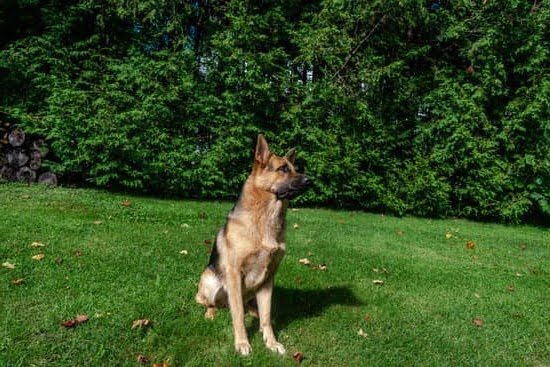Are you struggling with a dog that displays dominance issues? Learning how to train a dog with dominance issues is crucial for ensuring both your pet’s well-being and your own. Understanding the root causes of dominant behavior in dogs, identifying the signs, and implementing proper training methods are essential to address these challenges effectively.
Dogs have a natural instinct for social hierarchies, which often translate into dominant or submissive behaviors within a pack. In this section, we will delve into the concept of dominance in dogs, exploring how it manifests in their behavior and interactions. By gaining insight into the nature of dominance, you can better comprehend why your dog may be displaying such behavior.
Identifying dominance issues in your dog is the first step toward addressing them. We will discuss observable signs of dominance, such as excessive territoriality or refusal to obey commands. Understanding these behaviors will enable you to tailor your training approach to suit your dog’s specific needs. Stay tuned as we explore effective training techniques that can help establish a balanced relationship with your furry companion.
Identifying Dominance Issues in Your Dog
When it comes to training a dog with dominance issues, the first step is to recognize the signs of dominant behavior in your pet. Some common indications of dominance in dogs include growling or snapping when their space is invaded, attempting to control resources like food or toys, and resisting commands from their owner. It’s important for dog owners to be able to identify these behaviors early on so that they can address the issue effectively.
Here are some ways to identify dominance issues in your dog:
- Aggressive behavior towards other pets or people
- Refusing to follow basic commands
- Attempting to control resources such as food or toys
- Growling or snapping when their space is invaded
If you notice any of these behaviors in your dog, it’s crucial to take action and address the dominance issues before they escalate further.
In addition, it’s essential to consider the breed of your dog, as certain breeds are more prone to showing dominant behavior. For example, breeds originally bred for guarding purposes or those with strong guarding instincts may exhibit more dominant tendencies. Understanding your dog’s breed-specific traits can help you better identify and address dominance issues.
The Importance of Proper Training for Dominant Dogs
Proper training is essential for correcting dominance issues in dogs. Without the right training, dominant behavior can escalate and cause potential harm to both the dog and its owners. Here are some important reasons why proper training is crucial for dominant dogs:
- Prevents Aggressive Behavior: Training helps to modify and correct aggressive behaviors associated with dominance, such as growling, biting, or showing teeth.
- Establishes Rules and Boundaries: Training helps to set clear rules and boundaries for the dog to follow, which is essential in addressing their dominant tendencies.
- Promotes Socialization: Proper training allows dominant dogs to be socialized in a controlled environment, helping them to interact positively with other animals and people.
In order to address dominance issues in dogs through training, it is important for the owner to establish themselves as the pack leader. By assuming this role, the owner can effectively manage their dog’s behavior and prevent any potential challenges for the leadership position. Additionally, positive reinforcement training methods have shown to be effective in addressing dominance issues in dogs.
- Rewards for Good Behavior: Using treats or praise to reward desirable behaviors can help reinforce positive actions in dominant dogs.
- Consistency: Consistent training methods and commands will help establish a routine and ensure that the dog understands what is expected of them.
- Patience: Training a dominant dog can be challenging, so it’s important for owners to remain patient throughout the process.
For severe cases of dominance issues, seeking professional help from a certified dog trainer or behaviorist may be necessary. These professionals have the expertise to tailor a training program based on the specific needs of a dominant dog. By following these approaches, owners can create a safe and structured environment while building a strong bond with their dogs through training.
Establishing Yourself as the Pack Leader
One of the key steps in training a dog with dominance issues is establishing yourself as the pack leader. Many dominant dogs may try to challenge their owners for leadership, so it is crucial to assert your position as the authority figure in the relationship. This can be achieved through consistent and firm leadership, setting boundaries, and providing clear communication with your dog.
To establish yourself as the pack leader, it’s important to set rules and consistently enforce them. This means being firm and confident in your commands and not tolerating any disobedience or challenging behavior from your dog. It also involves controlling important resources such as food, toys, and attention to reinforce that you are the one in charge. By taking on this role, you can help your dog feel more secure and less anxious, ultimately reducing their dominant tendencies.
In addition to setting rules and boundaries, it’s essential to provide clear communication with your dog. Use positive reinforcement techniques such as praise, treats, and rewards to encourage good behavior while also addressing any dominant behavior promptly and firmly. Showing consistency in your actions will help your dog understand that you are the leader they can trust, making it easier for them to follow your guidance during training sessions.
Positive Reinforcement Training Methods for Dominant Dogs
Using positive reinforcement is a highly effective approach when training dominant dogs. Positive reinforcement involves rewarding your dog with treats, praise, or toys when they exhibit the desired behavior. This method focuses on encouraging good behavior rather than punishing bad behavior, which can be counterproductive with dominant dogs. When using positive reinforcement, it is important to reward your dog immediately after they display the desired behavior to reinforce the connection between the action and the reward.
One effective way to use positive reinforcement with dominant dogs is through clicker training. This involves using a clicker – a small handheld device that makes a clicking sound – to signal to your dog that they have performed the correct behavior. The click is then followed by a treat or praise, creating positive associations for your dog. Clicker training can be particularly beneficial for dominant dogs as it allows for clear and immediate communication between you and your pet.
Another key aspect of positive reinforcement training for dominant dogs is understanding what motivates your specific pet. While food treats are often a popular choice for rewards, some dogs may respond better to verbal praise or playtime. It’s important to observe and learn about what motivates your dog to tailor the rewards accordingly, ensuring that the positive reinforcement is truly reinforcing the desired behavior in your dominant dog.
| Training Method | Description |
|---|---|
| Positive Reinforcement | Rewarding good behavior with treats, praise, or toys. |
| Clicker Training | Using a clicker tool to signal correct behavior followed by a reward. |
| Motivation-based Rewards | Understanding what motivates your dog and tailoring rewards accordingly. |
Consistency and Patience in Training
Training a dog with dominance issues requires a great deal of consistency and patience. It’s important to understand that changing your dog’s behavior will take time and effort, and success won’t happen overnight. Consistent training involves setting clear boundaries and expectations for your dog, and enforcing these rules consistently. This means not allowing any exceptions to the rules, as this can confuse your dog and undo all the progress you’ve made.
Patience is also crucial when training a dominant dog. It’s normal for progress to be slow at times, especially if your dog has deeply ingrained behavioral issues. Losing patience or becoming frustrated with your dog can have a negative impact on their training, as dogs are highly sensitive to their owner’s emotions. It’s important to remain calm, positive, and patient throughout the entire training process.
In addition to consistency and patience, it’s also essential to stay committed to the training regimen you’ve established for your dominant dog. This means dedicating time every day to work with your dog on obedience training, socialization, and other behavior modification exercises. Consistent practice is key to reinforcing good behaviors and gradually reducing dominant tendencies in your dog.
| Consistency | Patience |
|---|---|
| Setting clear boundaries | Remaining calm and positive |
| Enforcing rules consistently | Avoiding frustration |
Seeking Professional Help for Severe Dominance Issues
When to Seek Professional Help
If your dog’s dominance issues are severe and pose a threat to you, your family, or other pets, it is imperative to seek professional help. Signs of severe dominance aggression may include growling, snarling, snapping, or biting when challenged. It’s important not to wait until a serious incident occurs before seeking the assistance of a professional dog trainer or behaviorist.
Choosing the Right Professional
When seeking professional help for your dog’s dominance issues, it is essential to find a certified dog trainer or behaviorist who specializes in working with dominant dogs. Look for someone who uses positive reinforcement training methods and has experience with behavior modification in aggressive dogs. Additionally, seek recommendations from trusted sources such as your veterinarian or other dog owners who have successfully addressed similar issues with their pets.
The Benefits of Professional Intervention
Professional trainers and behaviorists have the knowledge and expertise to assess your dog’s behavior accurately and develop a customized training plan to address their dominance issues. They can also provide guidance on implementing management strategies within your home environment to ensure safety while working on behavior modification. Seeking professional help can facilitate quicker progress in improving your dog’s behavior and ultimately create a safer and more harmonious relationship between you and your pet.
Creating a Safe and Structured Environment for Your Dog
Consistent Routine and Schedule
Establishing a consistent routine and schedule for your dog can help them feel secure and balanced. This includes regular feeding times, exercise routines, and designated playtime. Dogs with dominance issues thrive on structure and knowing what to expect each day. By establishing a routine, you are providing a sense of stability that can aid in managing their behavior.
Setting Boundaries
It’s important to set clear boundaries for your dominant dog within the home. This can include designating specific areas where they are allowed or not allowed, as well as establishing rules for behaviors such as jumping on furniture or entering certain rooms. Consistency in enforcing these boundaries is key to helping your dog understand their place in the household hierarchy.
Providing Mental Stimulation
In addition to physical exercise, providing mental stimulation for your dominant dog is crucial. Interactive toys, food puzzles, and training sessions can help keep their minds engaged and prevent boredom or frustration that may lead to behavioral issues. Mental stimulation also gives your dog an opportunity to focus their energy on productive activities rather than displaying dominance-related behaviors.
By creating a safe and structured environment for your dog, you are laying the foundation for successful training and behavior management. Consistency, patience, and clear communication will be key elements in helping your dominant dog feel secure and thrive in their role within the family pack.
Tips for Dealing With Dominance Aggression
Dealing with dominance aggression in dogs can be challenging, but it is essential to address this issue to ensure the safety of both the dog and those around them. Dominance aggression can manifest in various ways, including growling, snarling, snapping, or even biting. It is crucial to deal with these behaviors promptly and effectively to prevent any potential harm.
One tip for dealing with dominance aggression in dogs is to avoid any confrontational or aggressive behavior yourself. Reacting forcefully to a dominant display from your dog can worsen the situation and lead to further aggression. Instead, remain calm and assertive, establishing yourself as the pack leader without resorting to intimidation or physical force.
Consistency in training is also key when dealing with dominance aggression. Set clear boundaries and rules for your dog and consistently enforce them. It is important not to make exceptions or give mixed signals, as this can confuse the dog and reinforce their belief that they are in charge. Consistent training will help your dog understand their place in the pack hierarchy and reduce their aggressive tendencies over time.
Building a Strong Bond With Your Dog Through Training
In conclusion, training a dog with dominance issues is not an easy task, but it is crucial for the well-being of both the dog and its owner. By understanding dominance in dogs and recognizing the signs of dominance issues, owners can take the necessary steps to establish themselves as the pack leader and provide proper training for their dogs.
Positive reinforcement methods, consistency, patience, and creating a safe and structured environment are essential components of successfully training a dominant dog.
Seeking professional help may be necessary for severe dominance issues, as aggression and other behavioral problems can pose risks to both the dog and those around it. However, with dedication and commitment, many owners can make positive progress in addressing their dog’s dominance issues through training.
Ultimately, building a strong bond with a dog through training is possible even when dealing with dominance issues. Training allows for clear communication between the owner and the dog, leading to mutual trust and respect. With the right approach, owners can develop a rewarding relationship with their dogs while effectively managing any dominance issues that may arise.
Frequently Asked Questions
How Do You Fix a Dog’s Dominance Behavior?
Fixing a dog’s dominance behavior requires consistent training and clear communication from the owner. This can involve setting boundaries, maintaining a calm and assertive energy, and reinforcing positive behaviors while discouraging negative ones. It’s important to establish yourself as the pack leader and show the dog that you are in control.
How Do You Break a Dog’s Reactivity?
Breaking a dog’s reactivity involves desensitization and counter-conditioning techniques. This means gradually exposing the dog to whatever triggers their reactive behavior, while rewarding them for calm, non-reactive behavior. It also requires patience, consistency, and seeking professional help if the reactivity is severe.
Can a Dominant Dog Be Trained?
Yes, a dominant dog can be trained with the right approach and dedication from the owner. Training should focus on building trust and respect between the dog and owner, establishing clear rules and boundaries, and providing regular mental and physical exercise for the dog. Consistency in training methods is also crucial for successfully training a dominant dog.

Welcome to the blog! I am a professional dog trainer and have been working with dogs for many years. In this blog, I will be discussing various topics related to dog training, including tips, tricks, and advice. I hope you find this information helpful and informative. Thanks for reading!





